Stacking Two Columns in One Cup
Here's a video I uploaded to youtube. The goal is to separate four blue dice and four red dice into two different columns, using one cup.
The explanation on how I learned to do this (below) first appeared in the April/May/June 2007 issue of JUGGLE magazine. JUGGLE is the official publication of the International Jugglers' Association.
Stacking two columns of dice in one cup is pretty easy. The technique is explained in The Dice Stacking Book and The Dice Stacking DVD. Click here to find out more about the book, the DVD, and dice stacking supplies.
Basically, if you can stack four dice into one column, the same technique will have you stacking eight dice in two separate towers. The interesting part of this move is to get all of the dice to end up in columns with distinct colors.
I should confess, after spending a good bit of time on this variation, I believe that controlling which die ends up in which column is random, at best. While separating the dice into two, uniquely colored columns makes a great video, the outcome is a bit too haphazard to perform the "separating into colors double stack" in front of a live audience.
The way that I learned this move was to work with two sets of dice. One set consists of four red dice. The second set consists of four dice, none of which are red, and all are visibly different from each other.
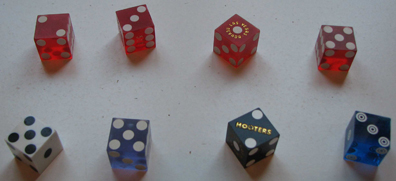
In the photo (above) the four dice in the back row are all red with solid white spots. The four dice in the front row are all different (white with black spots, blue with white spots, black with white spots, and blue with bird's eye spots).
With a lot of patience I started collecting all eight dice in one cup, and stacking them into two columns. The goal was to see if there was some initial formation that naturally split the dice into two columns by color. I made a mental note of any of the results that looked promising. Some of the initial formations I tried can be seen below.
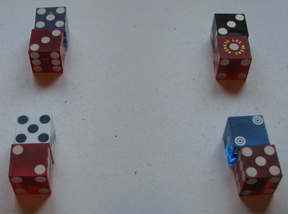
The four red dice are in the front of each set of two dice.
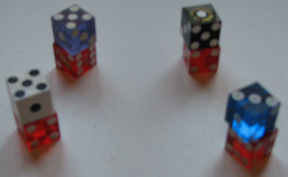
The four red dice are on the bottom of each set of two dice.
I noticed that this particular formation tended to create a column that frequently ended with three red dice in one column.
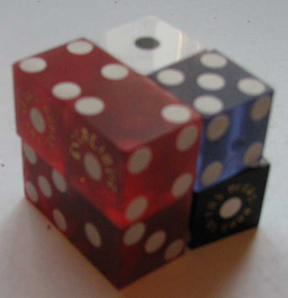
The four red dice create one wall. The four "other" create the second wall.
At that point I began systematically trying out variations of this basic block. The next step was to see which one of the red dice did not stay with its mates. That was fairly easy to determine. Separate one non-red die for a red die. Stack all eight of the dice and see if one column still had three red dice in it. Change the position of the non-colored die to see which red die does not end up with its mates.
I then knew which three red dice consistently ended up in the same column. The final step was to try the fourth red die in the different four positions of the "other" dice to see which position would get that one red die back to the column with the other red dice.
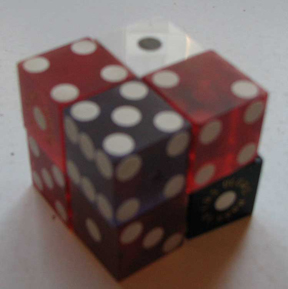
One blue dice has been added to the wall of three red dice. The single red die moved to the front, top position of the wall of "other" dice.
After several practice sessions I felt confident that I could get the two columns to arrange themselves by color on a regular basis. While I couldn't get this unique final color arrangement to work 100% of the time, it was occurring more and more consistently.
Performing in front of a video camera is pretty easy. Set things up and run the tape. As it turns out, I achieved the results I wanted on the fifth take. That was good enough for me. Time to put the equipment away and edit the video for uploading to Youtube.
If you are interested in trying to achieve the same result here are my tips:
Don't assume that what works for me is necessarily going to be the best solution for you. I suspect that the way the dice tend to tumble inside of the cup is highly dependent on personal factors such as how fast you collect the dice, the angle at which you hold the cup, how wide of an arc you swing, the interior dimensions of our cup, and probably several other factors.
I found that an important factor was the angle at which the block of eight dice was presented to the cup. For example, I had much more success if I set up the block perpendicular to my line of site, and then turned the entire block forty-five degrees counterclockwise. If I began with the same initial formation and turned the block forty-five degrees clockwise, the dice exhibited no consistent manner of forming into two distinct columns.
Good luck. I look forward to seeing what other people come up with.
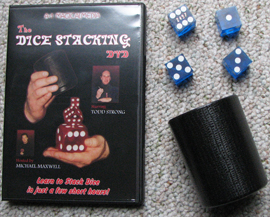
Special Deal - BLUE: The Dice Stacking DVD with BLUE Dice Stacking Kit (four BLUE cancelled casino dice and dice stacking cup)
Save a few bucks - just $25.95 plus shipping
shipping charges at right
| Ship to: | Shipping charge | |
| U.S.A. |
Total: $28.92 |
$2.57
Airmail, three days |
| Canada |
Total: $28.65 |
$2.70 four to seven business days Airmail |
| Europe | Total: $32.70 |
$6.75 four to seven business days Airmail |
| The Rest of the World
Oceania, Asia, Africa, South America |
Total: $33.45 |
$7.50 four to seven business days Airmail |

- Home
- About
- Ball Juggling
- Cigar Boxes
- Club Juggling
- Club Swinging
- Comedy Writing
- Cup Stacking
- Devil Sticks
- Diabolo
- Diabolo Postcards
- Dice Stacking
- Hat Manipulation
- Lasso
- Miscellanous Juggling
- Parachute Games
- Poi Swinging
- Ring Juggling
- Shaker Cups
- Skill Games
- Staff
- Tennis Balls and Can
- New Games Foundation
- Ordering and Shipping
- Contact Information
- Peeps (photos of birds and stuff)
- Personal Thoughts
- Workshops
- Links
- Questions? Comments? Feedback?